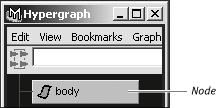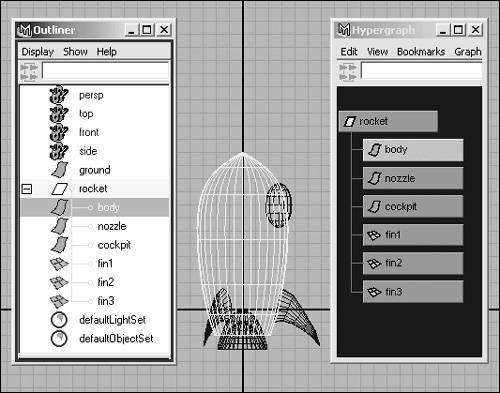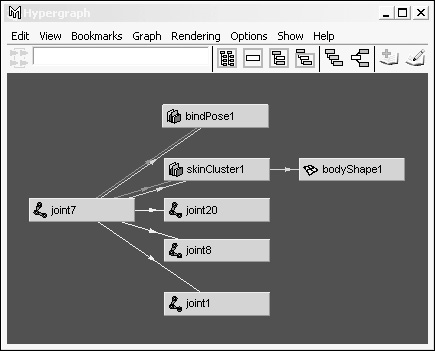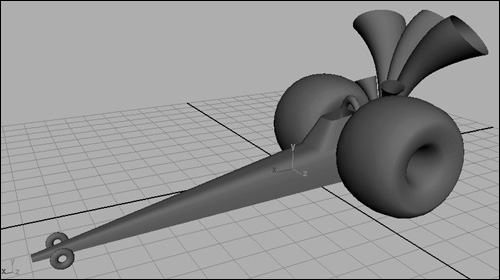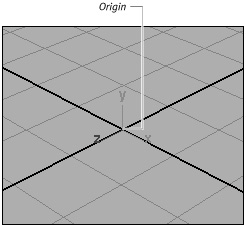About Maya
|
| Maya is a node-based program. A node is a visual representation of an element, such as a surface, texture, or animation curve. Every element in Maya is represented by a node or several connected nodes (Figure 1.1). The nodes themselves are made up of many attributes, which are the information that defines the node, such as an object's position or size. You access nodes in the Outliner and Hypergraph (Figure 1.2) windows. The advantage of this node-based architecture is that it gives you precise control over which nodes get connected to or disconnected from other nodeswhich in turn determines the behavior and look of the object. Maya lets you view all of a scene's connections from within the Hypergraph (Figure 1.3). The arrows and lines represent the connections. (The Hypergraph is covered in more detail later in this chapter.) Figure 1.1. Nodes can be viewed in the Hypergraph or the Outliner. A new node is created for each object. Figure 1.2. A Maya scene file can consist of a limited number of nodes and connections, or it can have thousands of nodes in more complex scene files. Figure 1.3. Node connections can be seen in the Hypergraph, with arrows showing the connections between the nodes and the directions of those connections. Maya's coordinate systemTraditional animation and graphics applications, like Adobe Photoshop, work with two axes, usually x and y (Figure 1.4). An x and y coordinate system provides height and width but lacks the depth to make objects appear three-dimensional. Maya adds a third axis, z, which gives objects depth (Figure 1.5). The addition of the third axis lets you create proportionally accurate models and animations. Figure 1.4. Flat, 2D graphics work with the x and y axes but lack a depth axis that enables images to become three-dimensional.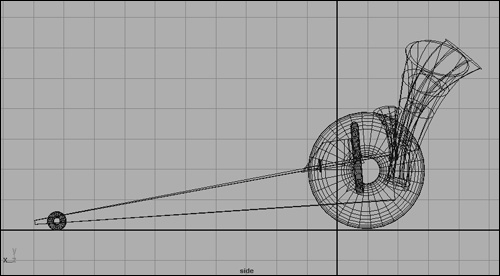 Figure 1.5. Adding another axis allows objects to become three-dimensional. These 3D models can now become accurately represented. Within the XYZ coordinate system are two kinds of coordinates, world and local. World coordinates start at the center of the scene in location 0, 0, 0, called the origin (Figure 1.6). Local coordinates are those around the area of the object. Figure 1.6. The center point of the Maya scene is called the origin. All directional values start at 0 from the origin. Objects themselves have what's called UV coordinate space. A surface has a U direction and a V direction. In the simple example of a plane, the U direction goes from left to right, and the V direction goes from top to bottom (Figure 1.7). It's like latitude and longitude on a world map. Just as you can find a position on earth by its latitude and longitude, you can determine a position on a surface by its U and V coordinates. This becomes especially important when positioning textures on a surface. Figure 1.7. Each surface is described with a U direction and a V direction. You can place curves on surfaces using U and V coordinates. |
|
- Chapter III Two Models of Online Patronage: Why Do Consumers Shop on the Internet?
- Chapter IV How Consumers Think About Interactive Aspects of Web Advertising
- Chapter VII Objective and Perceived Complexity and Their Impacts on Internet Communication
- Chapter XIV Product Catalog and Shopping Cart Effective Design
- Chapter XVI Turning Web Surfers into Loyal Customers: Cognitive Lock-In Through Interface Design and Web Site Usability
